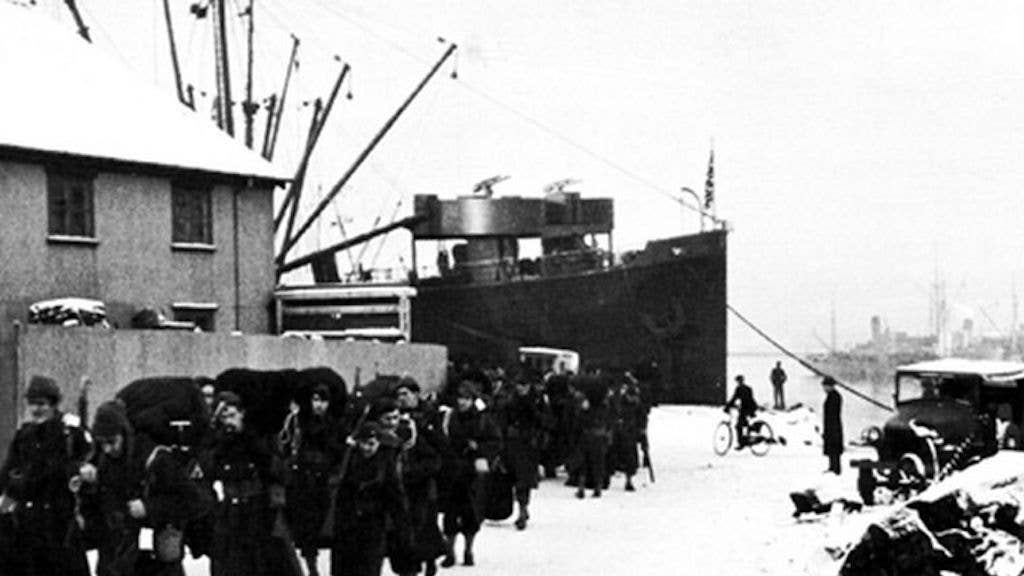How Iceland was invaded twice during World War II

Arrival of US troops in Iceland in January 1942.
SUMMARY
When the Kingdom of Denmark fell to the Nazi blitzkrieg in April 1940, the German occupation of Denmark was a clear blow to the Allies. As in World War I, German Navy U-boats roving the Atlantic Ocean had the potential to literally starve the British Isles of war material, fuel and food coming from Canada and the United States. While Denmark had remained neutral in World War I, with the kingdom’s formal surrender to Germany in 1940, the idea of U-boats operating out of the Danish North Atlantic territories of the Faroe Islands, Greenland, and Iceland created a real crisis for the United Kingdom.
Conversely, these islands were strategic locations for Allied naval and air force convoy protection operations. Britain had no choice but to take swift action to protect its vital North Atlantic shipping lifeline. Later in the month of April 1940, three British Royal Navy ships promptly arrived at the Faroe Islands, just 200 miles north of the Scottish coast, to prevent an invasion by German forces. Soon, a small contingent of Royal Marines occupied the islands. The Faroes enjoyed a large degree of autonomy from Denmark, and its residents informally accepted the occupation, but under official protest.
Iceland also enjoyed autonomy from Denmark, and Britain invited Iceland to reject Denmark’s surrender to Germany and join the Allied cause. Iceland quickly declined the invitation, so on May 10, 1940, a British force consisting of the Royal Navy and over 750 Royal Marines invaded Iceland under the codename Operation Fork, violating the island’s neutrality. The forces arrived in the Icelandic port and capital city of Reykjavik. Aside from a perfunctory inquiry by the harbor master and port police, no resistance was made toward the British force. After procuring local transport, the British forces fanned out across the island to secure vital communications and transportation centers, and post marines on likely beach invasion sites. Iceland’s government did issue a formal protest and a strong demand for compensation for any damages and payment for commandeered property and equipment, which the British commander quickly agreed to. Just one week later, on May 17, 1940, 4,000 Canadian Army troops arrived to relieve the Royal Marines.
When the British took control of Iceland, the German military considered invading the island itself, under a plan called Operation Ikarus, however, the reality of insufficient air and naval forces and vulnerable supply lines quickly shelved the plan. Eventually, British Commonwealth occupation forces totaled over 25,000 personnel dedicated to protecting the island and elements of the Royal Air Force, Royal Navy and Royal Canadian Navy performing convoy protection duties.
Although still technically neutral, in the face of increased German attacks on U.S. ships in the Atlantic, the United States sent over 4,000 U.S. Marines to Iceland in July 1941, in the island’s second invasion. In a bit of diplomatic “sleight of hand," Britain, Iceland, and the U.S. termed the arrival of American forces as an act of a neutral power protecting the interests of another neutral nation. The presence of U.S. forces conveniently allowed Britain to redeploy its soldiers desperately needed for combat in North Africa.
When the U.S. entered the war in December 1941, after the Japanese attack on Pearl Harbor, Hawaii, U.S. Army troops replaced the American Marines, and over 30,000 American military personnel began serving on the island at any one time. British and Canadian air forces and navies continued to operate from Iceland to the end of the war.
During the course of the war, the German Luftwaffe attacked the Faroe Islands several times, and Icelandic fishing fleets suffered losses from German seaborne mines and U-boat attacks.
In 1944 Iceland formally declared its independence from Denmark. At the end of the war, most Allied forces left the island. One benefit of the Allied occupation was the tremendous amount of road, maritime and airport infrastructure constructed on the island. Due to the growing post-war aggressiveness of the Soviet Union, U.S forces returned to Iceland in 1947, and the Republic of Iceland became a member of the North Atlantic Treaty Organization (NATO) in 1949 when the alliance was formed.
The U.S. Air Force and then Navy operated a large airfield that became Naval Air Station (NAS) Keflavik from 1947-2006, basically performing the same antisubmarine mission it had during World War II, except this time the Soviet Navy was the adversary. In 2015, in the face of increased aggression by the Russian Federation, NAS Keflavik was reopened. The airfield is an operating base for U.S. Navy P-8 Poseidon anti-submarine and intelligence-collecting aircraft, and rotational NATO fighter aircraft, including the British Royal Air Force.
SHARE
